
Ukrainian Su-27s like this one teamed with MiG-29s and ground-based defense to keep Russian fighters at bay after the first few weeks of the invasion.
Months before the Russian Army violently poured over Ukraine’s borders on Feb. 24, 2022, the regime in Kyiv had launched a campaign to modernize an aged and outgunned Ukrainian Air Force with Western-built fighters, seeking to backfill the airborne layer of the country’s air defense and supply a key ingredient for modern, combined arms maneuvers.
Despite a ready supply of dozens of available fighters since the latest phase of the conflict began 15 months ago, the intense pressure campaign from Kyiv, which involved the Ukrainian president, air force commanders and rank-and-file flyers, faced entrenched opposition in some Western capitals. For two years, critics of Ukraine’s demands for fighters prevailed, preferring instead to devote tens of billions of dollars in military aid to supplies of ground-based air defense systems, precision artillery and armored vehicles.
- Fighters coming too late to support planned offensive
- Key details of aircraft types, weapons and sustainment still being reviewed
But the mood shifted suddenly on May 19. During a stop at the G7 Summit in Japan, U.S. President Joe Biden pledged his support for training Ukrainian fighter pilots. Biden also withdrew his administration’s resistance to allowing allies and partners to send to Kyiv their own U.S.-built fighters, such as ex-European Lockheed Martin F-16s and ex-Australian Boeing F/A-18s.
Such moves previously had triggered fears of Russian retaliation, but the White House no longer seemed concerned. Asked on May 21 to respond to a follow-up warning from the Kremlin that sending F-16s to Ukraine posed a “colossal risk,” Biden shrugged off the implied threat, saying: “It is, for them.”
But the long-awaited approval came months too late for Ukraine’s much-anticipated summer offensive. Ukrainian Defense Minister Oleksii Reznikov told Japanese reporters on June 4 that the coveted Western fighters will not be available for deployment until this autumn or winter. Moreover, key details remain undecided or unannounced, such as the number and types of fighters under discussion, the weapons those aircraft will be allowed to employ and any plans for helping Ukraine maintain an unfamiliar aircraft fleet and replace any losses.
Those questions have been asked in Kyiv since March 2021, nearly a year before Russian columns advanced across the southern, eastern and northern borders of Ukraine. Col. Gen. Serhiy Drozdov, the then-Ukrainian Air Force commander, informed a Kyiv parliamentary committee in March 2021 that his entire tactical aviation portfolio—composed solely of the Sukhoi Su-24s, Su-25s, Su-27s and Mikoyan MiG-29s inherited by Kyiv upon independence in 1991—could not be sustained beyond 2030.
Ukraine needed to launch a massive investment in Western fighters, which would require unprecedented spending on defense modernization. Ukraine’s total budget for acquiring modern weapon systems in 2021 amounted to 22.7 billion hryvni ($615 million). Drozdov unveiled a vision for a 15-year, three-phase tactical aviation plan costing nearly $12 billion.
The vision also called for acquiring Saab Gripen E/F or Lockheed Martin F-16V fighters in the first five years to replace MiG-29s, which would be followed by Boeing F-15EXs in the next five years to replace Su-27s. Finally, Drozdov proposed a third phase to acquire fifth-generation fighters by 2035—namely, the Lockheed F-35A.

To finance this sweeping modernization vision, Drozdov said the parliament should establish a separate state armaments program devoted solely to modernizing tactical aviation. Realizing that vision also would require the U.S. government to approve a massive package of arms exports aimed at a neighbor of an increasingly belligerent Russia. Stephen Blank, a Russia policy expert at the Foreign Policy Research Institute, urged the Biden administration to support Ukraine’s air power vision.
“Reinforcing Ukraine’s Air Force would be a powerful way for the Biden administration to signal that the U.S. will no longer tolerate Russian mischief in Eastern Europe,” Blank wrote in an April 2021 essay published by the Atlantic Council, “and that there are hard and tangible long-term strategic costs Russia must bear for its malign conduct.”
But support from the Biden administration never came, and Lt. Gen. Mykola Oleschuk replaced Drozdov as the Ukrainian Air Force commander in August 2021.
When Russian forces invaded six months later, Ukraine’s Air Force consisted of the same Soviet-era aircraft, equipped with the same mechanically scanned radars and R-27 semi-active radar homing missiles employed by the Soviets in the 1980s.
With the help of ground-based air defenses, the remnants of this aged fleet still has managed to deny Ukrainian airspace to more advanced Russia fighters, including Su-35s wielding R-77 active radar homing missiles and MiG-31s capable of launching R-37M air-to-air missiles against targets from dozens of miles within Russian-held territory. In recent months, Russian fighters have employed a new version of the FAB-500, featuring wing kits to extend the range of the precision-guided bomb.
Despite these dire threats, Ukraine’s Air Force struggled to win Western support even for being reinforced with ex-Russian fighters from former Warsaw Pact member states.
During the first weeks of the war, U.S. officials blocked a proposal to transfer Polish MiG-29s to Ukraine via a U.S. base in Germany. “We assess that adding aircraft to the Ukrainian inventory is not likely to significantly change the effectiveness of the Ukrainian Air Force relative to Russian capabilities,” then-Pentagon spokesman John Kirby said in March 2022. “The intelligence community has assessed the transfer of MIG-29s to Ukraine may be mistaken as escalatory and could result in significant Russian reaction.”
That same month, U.S. officials also rejected proposals to regenerate Fairchild Republic A-10s and Lockheed Martin F-16s in storage and send them to Ukraine. Air Force Secretary Frank Kendall said the timeline required to train Ukrainian forces to operate the aircraft made such transfers unfeasible. The U.S. government blocked allies from transferring retired F-16s and F/A-18s to Ukraine, too.
Ukraine’s aerial disadvantage has translated into heavy losses for its tactical aviation fleet. The Ukrainian government does not disclose military losses, but open-source intelligence blog Oryx has visually confirmed 62 lost Ukrainian fighters. The Oryx estimate likely is not comprehensive, but it appeared to be validated by Gen. James Hecker, the commander of U.S. Air Forces in Europe. In a public appearance in early March, Hecker said Ukraine entered the war with about 130 fighters but had lost about 60 of them. Hecker added that the Russian Air Force had lost about 70 fighters during the first year of the war, most probably shot down by ground-launched interceptor missiles.
As the conflict dragged on and successful Ukrainian operations exposed Russia’s tactical weaknesses, however, U.S. policy on transfers of aerial weapon systems to Ukraine started to evolve.
Ukrainian counterattacks from April to November liberated all of the Kyiv and Kharkiv oblasts and the right bank of the Dnipro River in the Kherson oblast. During the summer, the U.S. secretly integrated Raytheon AGM-88 High-Speed Anti-Radiation Missiles on Ukraine’s MiG-29s. The transfer gave the Ukrainian Air Force a weapon to target stationary radars safely from the air.
In December, the U.S. also pledged to send the Saab/Boeing Ground-Launched Small-Diameter Bombs (GLSDB). Equipped with M26 rocket motors and the wing-kitted SDB, this ground-launched system can mimic the role played by a light tactical bomber, allowing Ukrainian forces to strike stationary targets up to 93 mi. (150 km.) away. Although they could be useful weapons, no GLSDB systems are immediately available. The Saab/Boeing team still must complete development and qualify an operational launch system.
Within weeks, additional support came for the Ukrainian Air Force. U.S. allies, including the UK and France, confirmed they will provide basic training for Ukrainian fighter pilots, which possibly replaces air crews killed or injured so far during the war. Perhaps more provocatively, the UK also integrated the stealthy MBDA Storm Shadow cruise missile on Ukraine’s surviving Su-24s, enabling the tactical bomber to strike targets deep within Russian-held territory from a safe distance.

In Washington, support continued to build for reinforcing the Ukrainian Air Force at the one-year anniversary of the war. Biden categorically ruled out sending F-16s to Ukraine in early February, but some officials had begun revisiting the year-old proposal to backfill Ukrainian fighter losses with MiG-29s from the former Warsaw Pact, especially from Poland and Slovakia.
“Poland was at the forefront of providing jets to Ukraine. We were advocating very shortly after this war broke out to provide Ukraine with [our MiG-29s],” Adrian Kubicki, the consul general of Poland in New York, recently told Aviation Week. “The first initial reaction was not very positive. But over time, I think our allies understood that our point was very valid.”
Slovakia transferred the first four of 13 promised MiG-29s to Ukraine in March. In return, the U.S. agreed to sell a batch of 12 Bell AH-1Zs to Slovakia that had been built originally for Pakistan. By mid-April, Poland also delivered the first eight MiG-29s to Ukraine, allowing Kyiv to form a standard 12-aircraft squadron with donated fighters.
Ukraine’s demands for Western fighters persisted, however. As winter turned to spring, U.S. officials came around to accepting a long-term need to reinforce the Ukrainian Air Force. During a meeting of the Ukraine Defense Contact Group, several allies formally requested permission to train Ukrainian pilots to fly F-16s, Pentagon spokesman Brig. Gen. Patrick Ryder said during a May 23 press conference. U.S. Defense Secretary Lloyd Austin then submitted those requests to the National Security Council for a policy decision.
“There was unanimous agreement that this was something that we should and need to support,” Ryder said. In early May, Austin recommended that Biden approve pilot training and fighter transfers to Ukraine.
“We’re going to work closely with our allies and our partners on ensuring that the Ukrainian pilots are trained on the F-16, and then at some point in time, [Ukraine will] be able to have the actual aircraft,” Ryder said.
Ukrainian officials have said they need an initial delivery of 48 F-16s this year, then more aircraft in the future. In a move that evokes memories of Drozdov’s long-term vision unveiled in March 2021, Ukrainian President Volodymyr Zelenskyy on May 24 called for the air force to conduct a sweeping update of operations and infrastructure, with a goal of transitioning tactics and support concepts to suit Western aircraft.
Any Western-built fighters sent to Ukraine will face a formidable set of threats, including Russia’s ground-based air defenses and most advanced fighters, such as Su-35s and MiG-31s. These are the same kinds of threats that have prompted the U.S. and many other countries to invest in a new generation of fighters that feature either advanced electronic warfare systems and long-range passive sensors or, as in the case of the F-35, a combination of those systems with a low-observable planform.
Despite these threats, John Baum, a former U.S. F-16 pilot who has flown a privately owned MiG-29, says such a fighter still could be a “game-changer” for Ukraine’s Air Force. Baum, a senior resident fellow at the Mitchell Institute for Aerospace Studies, says the F-16s can make a difference in combination with other Ukrainian weapon systems.
“The F-16 or similar type of fighter would really augment the overall air power picture,” Baum says. “I’m really thinking about the mix of cyber and [unmanned air vehicle] capabilities from both a kinetic and nonkinetic perspective,” he says. “I would not say just because [anti-aircraft] systems like the S-400 are there would be a reason not to bring an air power asset like the F-16 into play.”
